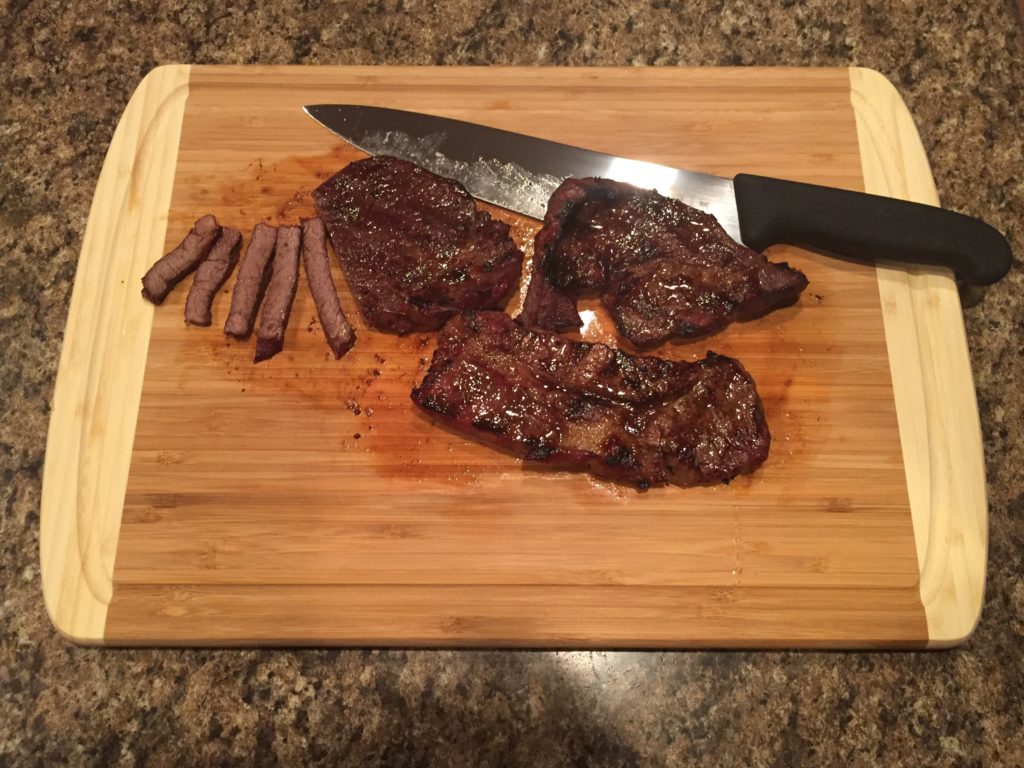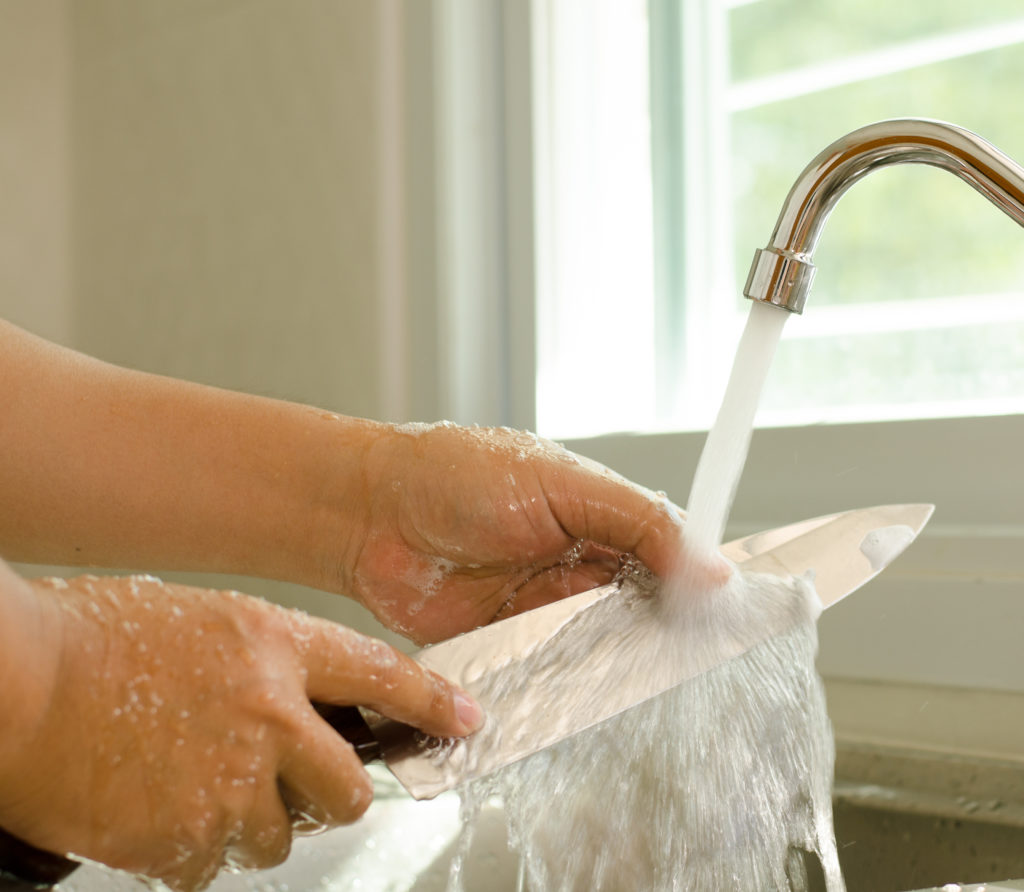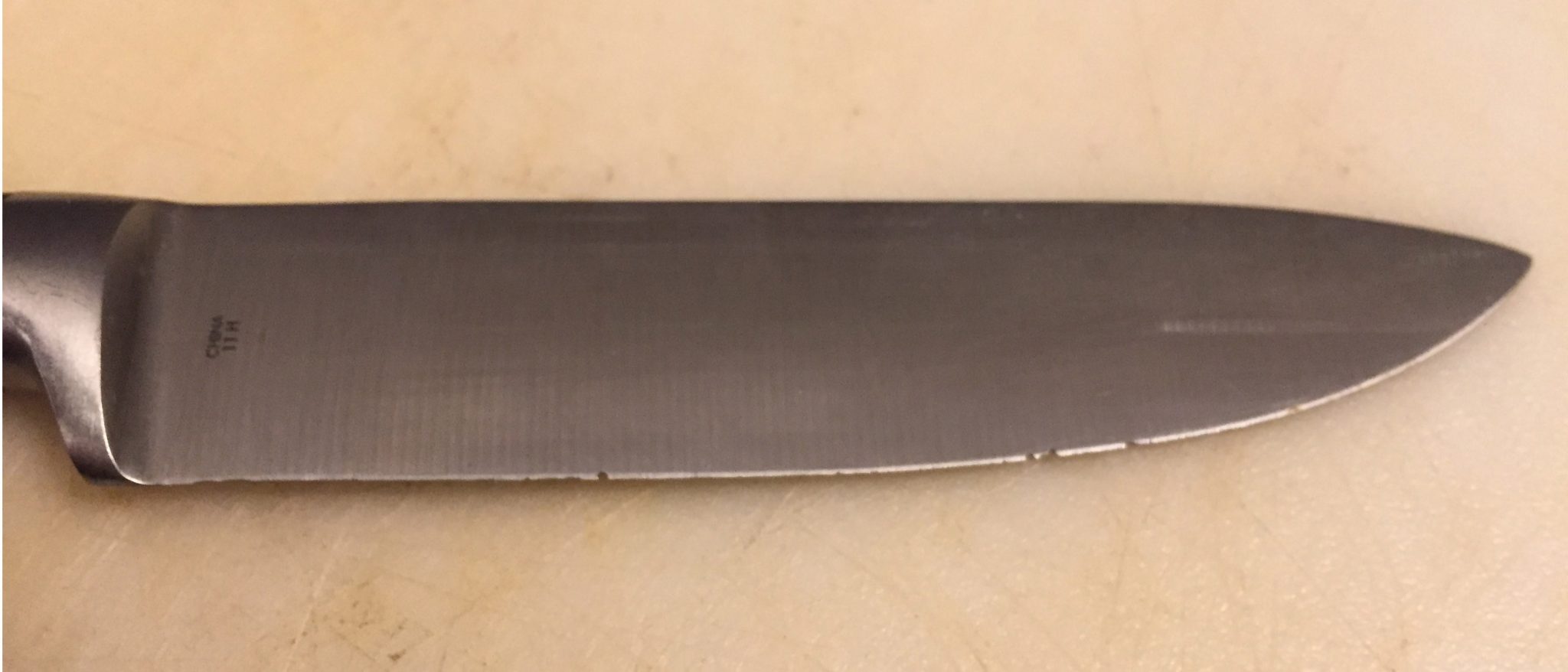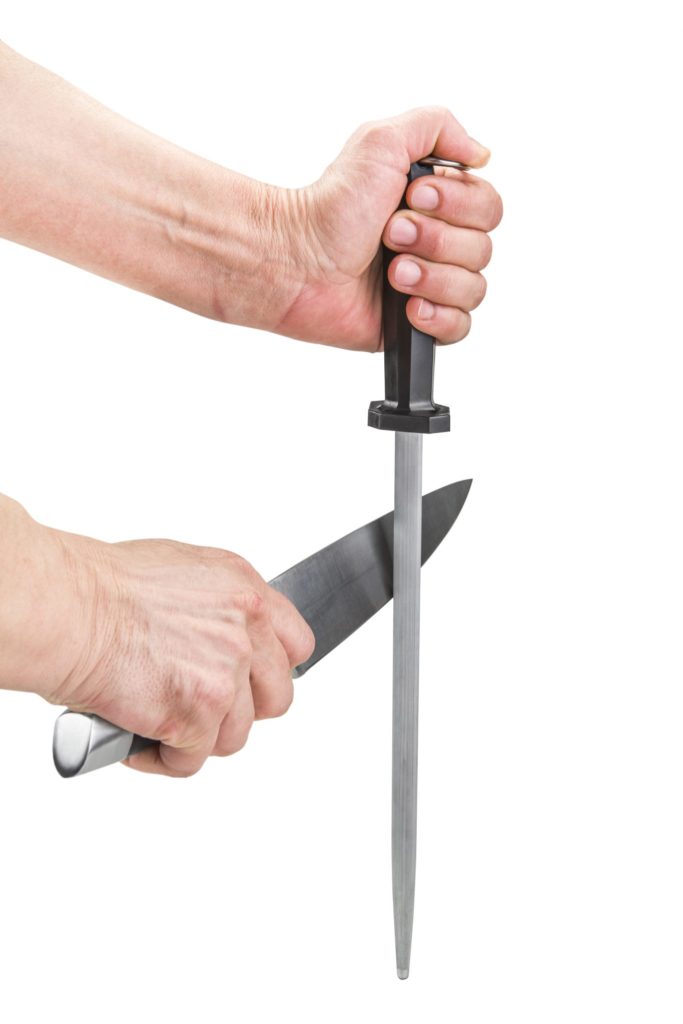Kitchen knives are an investment that you use about every single day. Using your knife, cleaning your knife, storing your knife, and maintaining your knife is the general cycle we all normally follow. The whole process gets repeated again each and every time you prepare a meal, but have you thought about the best way to keep your knives clean and ready for use? Here are some simple kitchen knife care tips to help your knives last as long as possible and always be ready for use:
- Using Your Kitchen Knife
- Cleaning Your Kitchen Knife
- Storing Your Kitchen Knife
- Honing Your Kitchen Knife
- Sharpening Your Kitchen Knife
Using Your Kitchen Knife
Notice: If you use one of our links to make a purchase, we may earn a commission at no additional cost to you. Learn more.
Kitchen knife care begins with how you use your knife. Make sure you are using the right knife for your particular cutting needs. For example, you do not want to be slicing a watermelon with a pairing knife. Also do not use your kitchen knives for unintended purposes such as tightening screws or breaking up ice cubes in the freezer.
Once you have the best knife for the job selected, get a cutting board to work on. Avoid cutting directly on your kitchen counter as granite, marble, laminate, and other surfaces are going to be harder than a cutting board. Also, be cautious with your cutting board material and use a gentle surface such as wood, bamboo, or plastic. Glass, marble, and granite are hard surfaces that could damage your knife blade with each use.
I currently like using an organic bamboo cutting board. Check out my Greener Chef Organic Bamboo Cutting Board Review!
Cutting steak with the Victorinox Fibrox Chef’s Knife on the Greener Chef Organic Cutting Board
Cleaning Your Kitchen Knife
Keep a damp towel nearby to wipe down your knife during use. It may be necessary to rinse it off with hot water and dry it to prevent food particles from sticking to your knife. This is especially important if you do not want to mix certain ingredients or flavors. If you are cutting multiple types of meat or a mixture of raw and cooked food then you should wash your knife with hot matter and mild soap to prevent cross-contamination.
Avoid putting your knife in the dishwasher. It may save you a lot of time in the kitchen; however, it’s an easy way to cause damage to your knives. The high-pressure water can cause your knives to bang around with other utensils which could damage your blade. Also, note that dishwashers are not a good option for wooden handles. It is always best to wash your knives by hand.
Do not leave your kitchen knives in the sink because they could become damaged with other kitchen equipment falling on or jostling against them. Knives in your sink create a dangerous environment for whoever washes the dishes. If they are not aware of the knives, they could cut themselves when they stick their hand into soapy water or under pots or pans in the sink. It’s best to wash your knife as soon as you are finished with it. If you are not able to wash it immediately, then rinse off or wipe down the blade until you are able to get to it.
Kitchen Knife Care – Steps to Washing Your Knife
- Rinse off any food particles that are stuck to your knife blade.
- Apply a mild soap and warm water to the knife blade and handle.
- Scrub knife with a kitchen brush or use a dish cloth to thoroughly clean it.
- Rinse knife off with warm water.
- Dry knife by hand to prevent moisture from causing corrosion and rust.
- Put knife away in proper storage option.
Hand Washing a Kitchen Knife
Storing Your Kitchen Knife
Kitchen knife care extends to how you store your knives. You don’t want to store your knives in the utensil drawer since throwing your knives into a drawer with other kitchen utensils and tools can wreak havoc with your knives. Every time you put something in or take something out you can scratch, ding, chip, and ultimately destroy your blade.
Knife blade damaged by improper care.
There are a variety of options to protect your knife such as storing it in a knife block, sheath, or on a magnetic strip.
Kitchen Knife Care – Knife Blocks
Your first thought when the term ‘knife block’ is mentioned probably goes back to the first knife set you ever owned. You know the one that you got at your wedding and became excited over because they all matched. Well, now kitchen knife blocks have advanced beyond the knife set and can be purchased on their own. Many people like to mix and match their knives, so a universal knife block provides an easy solution to storing your knives.
Kitchen Knife Care – Knife Sheaths
Kitchen knife sheaths protect your knife blade and also your hands. You can easily transport your knife with a sheath as well. Sheaths are normally made out of leather or plastic but other materials can be used. Even a piece of cardboard can be used to create a sheath.
Kitchen Knife Care – Knife Magnetic Strips
Kitchen knife magnetic strips provide a simple option for storing your knives. A magnetic strip allows you to get your knives off your counters and out of your drawers. They can be placed in a lot of creative places as well. For example, you can place them on the side of cabinets or refrigerators, on backsplashes, above kitchen sinks, etc. There are a variety of metal, wood, and plastic knife magnetic strips. Knife magnetic strips allow you to not only store your knives but also create a pretty cool-looking decoration and conversation starter.
Honing Your Kitchen Knife
Honing your knives is a vital part of your kitchen knife care. The process of honing is different than sharpening. Honing removes nicks/spurs and calibrates the blade back to its original angle. Whereas sharpening removes metal from the edge of the knife. A kitchen knife steel is used to hone a knife. It is a long, rounded tool made of steel with a handle at one end. Honing steels can be made of ceramic or diamond, but those types are more in the category of sharpeners.
Kitchen Knife Care – Steps to Honing Your Knife
- Hold the kitchen knife steel in your non-dominate hand.
- Place the bottom of the steel on a table or counter top. Use a cloth under the tip to prevent the steel from moving around.
- Place the edge of the knife closest to the handle against the rod at a 15-20 degree angle.
- Pull the knife down the steel and toward you while maintaining the angle. You should start at the heel of the knife and finish at the tip of the knife.
- Repeat 4-5 times while alternating on each side.
- Wipe the knife with a towel to clean any debris from the blade.
Honing a kitchen knife
Sharpening Your Kitchen Knife
Your kitchen knife only needs to be sharpened about once or twice a year depending upon how much you use it. Normally honing your knife as mentioned above will bring back the edge of your knife and can be done on a regular basis.
Kitchen Knife Care – Testing Your Knife’s Sharpness
A good test to determine if your knife is sharp is to cut through a piece of paper. Extremely sharp knives will usually slice a piece of paper with minimal downward force. A step down from that would be knives that can cleanly cut through a piece of paper with a motion of drawing back or pushing forward the blade. If your knife tears the paper or slides of the edge then it’s probably time to sharpen your knife.
If you are a DIY kind of person, then I suggest getting a whetstone to sharpen your knives. There are also other options such as manual or electric sharpeners that you pull your knife through. And if you are not confident in doing it yourself then you can have your knife professionally sharpened. There are local places and mail-out options for your kitchen knives to be sharpened.
Kitchen Knife Care – Steps to Sharpen Your Knife
A whetstone is one of the best options for sharpening your kitchen knives. Although experience is the best way to fine-tune your skills, I have provided some basic steps to sharpen your knives with a whetstone:
- Put the whetstone on a cutting board or in a holder to keep it from moving around with the coarse side face up.
- Hold the handle of the knife and place the edge against the stone. Angle the knife blade between 15-20 degrees. Place a match book under the knife to act a gauge.
- Apply pressure to the knife with your other hand and slide the blade along the stone.
- Continue to slide the knife blade in the same direction 8-10 times.
- Repeat the same process on the other side.
- Switch to a fine grit whetstone and repeat on both sides of your knife.
- You can follow up with using a knife steel to hone the blade.
- Clean your knife with a mild soap and warm water.
- Dry your knife and properly store for its next use.
Quick Tips
- When scraping food on your cutting board or moving it to your pan, turn your knife blade over and use the spine. This prevents your knife blade from getting damaged, and ensures you do not cut your hand.
- Use wood, bamboo, or specialty plastic cutting boards. Avoid glass, granite, marble, porcelain, and other materials as they can damage the blade.
- Keep your knife blades properly stored and protected in a knife block, sheath, or magnetic strip.



